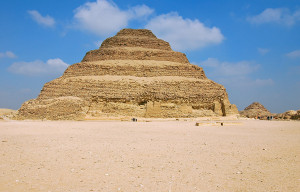Egypt’s larger than life pyramids continue to generate speculation about their origins, ranging from the extraterrestrial to the supernatural. Even the Egyptians once posited a divine explanation. The stepped pyramid at Saqqara shows that the real story is closer to earth.
Believing that souls live on after death, Egyptians initially buried their important dead and their possessions in underground tombs covered by “mastabas.” Mastabas, made first of mud bricks and then of stones, were solid, flat-topped structures up to 30 feet high, having gradually sloping sides. A passage to a special chamber inside allowed priests and family members to bring offerings to the person buried below for use in the afterlife.
In about 2650 B.C., Imhotep, the palace architect of Pharaoh Djoser, came up with a new idea for his boss’s tomb at Saqqara, the burial ground serving the capital at Memphis. He covered the underground tomb with six stacked mastabas of increasingly smaller size, creating a stepped pyramid made entirely of stone. For designing what was then the largest stone structure ever built, Imhotep was later worshipped as a god.
Seeing the stepped pyramid, Pharaoh Snefru ordered that his pyramid would eliminate the steps and support his tomb above the ground so it would be closer to the sun god. About two thirds of the way to the apex, engineers had to reduce the angle of inclination from 55 degrees to 43 degrees to eliminate stability problems created by the internal tomb chamber. The result was the so-called “bent pyramid.” On the next try, Snefru’s engineers started with a 43-degree angle and succeeded in creating the first “true pyramid,” with smooth sides and a constant angle. This so-called “red pyramid” may contain still secret passages leading to the undiscovered mummy of Snefru. Using Snefru’s model, his son Khufu took the pyramid building art to its pinnacle in the Great Pyramid of Giza, still the most massive structure ever built.
No little green men, no magical powers, no unsolvable mysteries. Egypt’s pyramid builders drew on past successes, learned from earlier mistakes and achieved lasting greatness. That is the real secret of the pyramids.

Comments are closed.